Combining Multichannel RSSI and Vision with Artificial Neural Networks to Improve BLE Trilateration
Abstract
1. Introduction
2. Methods Employed
2.1. Bluetooth Low Energy
2.2. Distance Model and Trilateration
2.3. Neural Network Algorithms
2.4. Human Body Detection
3. System Design
- Obtain the RSSI values for each channel corresponding to each of the transmitters when no people are blocking any signals.
- Repeat Step 1 with 1 or 2 people blocking some of the signals.
- For training, the inputs are selected from Steps 1 and 2 randomly, while the outputs can be only selected from Step 1, since they represent the RSSI values with no blockages. Most (70%) of the measurements in Steps 1 and 2 are used to train the ANN system.
- Evaluate and test with 30% of all measurements from Steps 1 and 2.
4. Experimental Setup
5. System Verification
6. Experimental Results
6.1. Detecting Humans and Correcting RSSI
6.2. Range and Position Estimation: Scenario #1 (at Training Locations)
6.3. Positioning Estimation: Scenario #2 (at Blind Test Points)
7. Conclusions
Author Contributions
Funding
Institutional Review Board Statement
Informed Consent Statement
Data Availability Statement
Conflicts of Interest
References
- Lachapelle, G. Gnss indoor location technologies. J. Glob. Position. Syst. 2004, 3, 2–11. [Google Scholar] [CrossRef]
- Mainetti, L.; Patrono, L.; Sergi, I. A survey on indoor positioning systems. In Proceedings of the 2014 22nd International Conference on Software, Telecommunications and Computer Networks (SoftCOM), Split, Croatia, 17–19 September 2014; pp. 111–120. [Google Scholar] [CrossRef]
- Alavijeh, A.K.; Ramezani, M.H.; Alavijeh, A.K. Localization improvement in wireless sensor networks using a new statistical channel model. Sens. Actuators A Phys. 2018, 271, 283–289. [Google Scholar] [CrossRef]
- Chaurasiya, V.K.; Jain, N.; Nandi, G.C. A novel distance estimation approach for 3D localization in wireless sensor network using multi dimensional scaling. Inf. Fusion 2014, 15, 5–18. [Google Scholar] [CrossRef]
- Kriz, P.; Maly, F.; Kozel, T. Improving Indoor Localization Using Bluetooth Low Energy Beacons. Mob. Inf. Syst. 2016, 2016, 2083094. Available online: https://www.hindawi.com/journals/misy/2016/2083094/ (accessed on 10 February 2020). [CrossRef]
- Contreras, D.; Castro, M.; de la Torre, D.S. Performance evaluation of bluetooth low energy in indoor positioning systems. Trans. Emerg. Telecommun. Technol. 2017, 28, e2864. [Google Scholar] [CrossRef]
- Zhao, X.; Xiao, Z.; Markham, A.; Trigoni, N.; Ren, Y. Does BTLE measure up against WiFi? A comparison of indoor location performance. In Proceedings of the European Wireless 2014: 20th European Wireless Conference, Barcelona, Spain, 14–16 May 2014; pp. 1–6. [Google Scholar]
- Faragher, R.; Harle, R. Location Fingerprinting With Bluetooth Low Energy Beacons. IEEE J. Sel. Areas Commun. 2015, 33, 2418–2428. [Google Scholar] [CrossRef]
- Bluetooth, S.I.G. Specification of the Bluetooth System-Covered Core Package, version 4.0; Bluetooth Special Interest Group: Kirkland, WA, USA, 2010. [Google Scholar]
- Kamath, S.; Lindh, J. Measuring Bluetooth® Low Energy Power Consumption; Application Note AN092; Texas Instruments: Dallas, TX, USA, 2010. [Google Scholar]
- Townsend, K.; Cufí, C.; Davidson, R. Getting Started with Bluetooth Low Energy: Tools and Techniques for Low-Power Networking; O’Reilly Media Inc.: Sebastopol, CA, USA, 2014. [Google Scholar]
- Heydon, R. Bluetooth Low Energy: The Developer’s Handbook; Prentice-Hall: Boca Raton, FL, USA, 2012. [Google Scholar]
- Filippoupolitis, A.; Oliff, W.; Loukas, G. Bluetooth low energy based occupancy detection for emergency management. In Proceedings of the 2016 15th International Conference on Ubiquitous Computing and Communications and 2016 International Symposium on Cyberspace and Security (IUCC-CSS), Granada, Spain, 14–16 December 2016; pp. 31–38. [Google Scholar]
- Tekler, Z.D.; Low, R.; Blessing, L. An alternative approach to monitor occupancy using Bluetooth low energy technology in an office environment. J. Phys. Conf. Ser. 2019, 1343, 012116. [Google Scholar] [CrossRef]
- Danişand, F.S.; Cemgil, A.T. Model-based localization and tracking using Bluetooth low-energy beacons. Sensors 2017, 17, 2484. [Google Scholar] [CrossRef]
- Collotta, M.; Pau, G. A novel energy management approach for smart homes using bluetooth low energy. IEEE J. Sel. Areas Commun. 2015, 33, 2988–2996. [Google Scholar] [CrossRef]
- Bargh, M.; de Groote, R. Indoor Localization Based on Response Rate of Bluetooth Inquiries. Available online: https://dl.acm.org/doi/abs/10.1145/1410012.1410024 (accessed on 10 February 2008).
- Kao, C.; Hsiao, R.; Chen, T.; Chen, P.; Pan, M. A hybrid indoor positioning for asset tracking using Bluetooth low energy and Wi-Fi. In Proceedings of the 2017 IEEE International Conference on Consumer Electronics—Taiwan (ICCE-TW), Taipei, Taiwan, 12–14 June 2017; pp. 63–64. [Google Scholar] [CrossRef]
- Wang, X.; Yuan, S.; Laur, R.; Lang, W. Dynamic localization based on spatial reasoning with RSSI in wireless sensor networks for transport logistics. Sens. Actuators A Phys. 2011, 171, 421–428. [Google Scholar] [CrossRef]
- Zhuang, Y.; Yang, J.; Li, Y.; Qi, L.; El-Sheimy, N. Smartphone-Based Indoor Localization with Bluetooth Low Energy Beacons. Sensors 2016, 16, 596. [Google Scholar] [CrossRef]
- Paterna, V.C.; Augé, A.C.; Aspas, J.P.; Bullones, M.A.P. A Bluetooth Low Energy Indoor Positioning System with Channel Diversity, Weighted Trilateration and Kalman Filtering. Sensors 2017, 17, 2927. [Google Scholar] [CrossRef]
- Huang, B.; Liu, J.; Sun, W.; Yang, F. A Robust Indoor Positioning Method based on Bluetooth Low Energy with Separate Channel Information. Sensors 2019, 19, 3487. [Google Scholar] [CrossRef]
- Nikodem, M.; Szeliński, P. Channel Diversity for Indoor Localization Using Bluetooth Low Energy and Extended Advertisements. IEEE Access 2021, 9, 169261–169269. [Google Scholar] [CrossRef]
- Naghdi, S.; O’Keefe, K. Detecting and Correcting for Human Obstacles in BLE Trilateration Using Artificial Intelligence. Sensors 2020, 20, 1350. [Google Scholar] [CrossRef]
- Naghdi, S.; O’Keefe, K. Trilateration With BLE RSSI Accounting for Pathloss Due to Human Obstacles. In Proceedings of the 2019 International Conference on Indoor Positioning and Indoor Navigation (IPIN), Pisa, Italy, 30 September–3 October 2019; pp. 1–8. [Google Scholar] [CrossRef]
- Bernabe, A.d.; Dios, J.R.M.; Ollero, A. Efficient integration of RSSI for tracking using Wireless Camera Networks. Inf. Fusion 2017, 36, 296–312. [Google Scholar] [CrossRef]
- Mikolov, T.; Karafiat, M.; Burget, L.; Khudanpur, S. Recurrent Neural Network Based Language Model. Chiba, Japan. Available online: https://www.isca-speech.org/archive/interspeech_2010/i10_1045.html (accessed on 7 March 2020).
- Simonyan, K.; Zisserman, A. Two-Stream Convolutional Networks for Action Recognition in Videos. In Advances in Neural Information Processing Systems 27; Ghahramani, Z., Welling, M., Cortes, C., Lawrence, N.D., Weinberger, K.Q., Eds.; Curran Associates, Inc.: New York, NY, USA, 2014; pp. 568–576. [Google Scholar]
- Viola, P.; Jones, M. Rapid object detection using a boosted cascade of simple features. In Proceedings of the 2001 IEEE Computer Society Conference on Computer Vision and Pattern Recognition. CVPR 2001, Kauai, HI, USA, 8–14 December 2001; p. I. [Google Scholar] [CrossRef]
- Ahonen, T.; Hadid, A.; Pietikainen, M. Face Description with Local Binary Patterns: Application to Face Recognition. IEEE Trans. Pattern Anal. Mach. Intell. 2006, 28, 2037–2041. [Google Scholar] [CrossRef]
- Dalal, N.; Triggs, B. Histograms of oriented gradients for human detection. In Proceedings of the 2005 IEEE Computer Society Conference on Computer Vision and Pattern Recognition (CVPR’05), San Diego, CA, USA, 20–25 June 2005; pp. 886–893. [Google Scholar] [CrossRef]
- Chen, M.; Hauptmann, A. Mosift: Recognizing Human Actions in Surveillance Videos; Technical Report; Carnegie Mellon University: Pittsburgh, PA, USA, 2009. [Google Scholar]
- Howard, A.G.; Zhu, M.; Chen, B.; Kalenichenko, D.; Wang, W.; Weyand, T.; Andreetto, M.; Adam, H. MobileNets: Efficient Convolutional Neural Networks for Mobile Vision Applications. Available online: https://arxiv.org/abs/1704.04861v1 (accessed on 7 March 2020).
- Jiao, J.; Li, F.; Deng, Z.; Ma, W. A Smartphone Camera-Based Indoor Positioning Algorithm of Crowded Scenarios with the Assistance of Deep CNN. Sensors 2017, 17, 704. [Google Scholar] [CrossRef]
- Lin, T.-Y.; Goyal, P.; Girshick, R.; He, K.; Dollar, P. Focal Loss for Dense Object Detection. 2017, pp. 2980–2988. Available online: http://openaccess.thecvf.com/content_iccv_2017/html/Lin_Focal_Loss_for_ICCV_2017_paper.html (accessed on 7 March 2020).
- Filippoupolitis, A.; Oliff, W.; Loukas, G. Occupancy detection for building emergency management using BLE beacons. In International Symposium on Computer and Information Sciences; Springer: Cham, Switzerland, 2016; pp. 233–240. [Google Scholar]
- Tekler, Z.D.; Low, R.; Gunay, B.; Andersen, R.K.; Blessing, L. A scalable Bluetooth Low Energy approach to identify occupancy patterns and profiles in office spaces. Build. Environ. 2020, 171, 106681. [Google Scholar] [CrossRef]
- Gutiérrez, M.E.B.; Sánchez, M.M.; Gallinas, R.B.; García, A.M.F. Capacity Control in Indoor Spaces Using Machine Learning Techniques Together with BLE Technology. J. Sens. Actuator Netw. 2021, 10, 35. [Google Scholar] [CrossRef]
- Kumar, D.P.; Amgoth, T.; Annavarapu, C.S.R. Machine learning algorithms for wireless sensor networks: A survey. Inf. Fusion 2019, 49, 1–25. [Google Scholar] [CrossRef]
- Isabona, J.; Srivastava, V.M. A Neural Network based Model for Signal Coverage Propagation Loss Prediction in Urban Radio Communication Environment. Int. J. Appl. Eng. Res. 2016, 11, 11002–11008. [Google Scholar]
- Wolfle, G.; Landstorfer, F.M. Field strength prediction in indoor environments with neural networks. In Proceedings of the Technology in Motion 1997 IEEE 47th Vehicular Technology Conference, Phoenix, AZ, USA, 4–7 May 1997; pp. 82–86. [Google Scholar] [CrossRef]
- Gong, Y.; Cui, C.; Yu, J.; Sun, C. An Indoor Localization Algorithm Based on RBF Neural Network Optimized by the Improved PSO. In Proceedings of the International Conference on Electronic, Information Technology and Intellectualization (ICEITI), Guangzhou, China, 18–19 June 2016; DEStech Publications, Inc.: Lancaster, PA, USA, 2016; pp. 457–464. [Google Scholar] [CrossRef][Green Version]
- Schloter, P.; Aghajan, H. Wireless symbolic positioning using support vector machines. In Proceedings of the 2006 International Conference on Wireless Communications and Mobile Computing, Vancouver, BC, Canada, 3–6 July 2006; Association for Computing Machinery: New York, NY, USA, 2006; pp. 1141–1146. Available online: https://dl.acm.org/doi/abs/10.1145/1143549.1143778 (accessed on 3 March 2020).
- Takenga, C.M.; Ieee, S.M.; Kyamakya, K. Pre-Processing of Data in RSS Signature-Based Localization. In Proceedings of the 3rd Workshop on Positioning, Navigation and Communication, Hannover, Germany, 16 March 2006. [Google Scholar]
- Wu, B.F.; Jen, C.L.; Chang, K.C. Neural fuzzy based indoor localization by Kalman filtering with propagation channel modeling. In Proceedings of the 2007 IEEE International Conference on Systems, Man and Cybernetics, Montreal, QC, Canada, 7–10 October 2007; pp. 812–817. [Google Scholar] [CrossRef]
- Hu, Y.H.; Hwang, J.N. Handbook of Neural Network Signal Processing; CRC Press: Boca Raton, FL, USA, 2002. [Google Scholar]
- Bishop, C.M. Neural Networks for Pattern Recognition; Oxford University Press: Oxford, UK, 1995. [Google Scholar]
- Hussin, R.; Juhari, M.R.; Kang, N.W.; Ismail, R.C.; Kamarudin, A. Digital Image Processing Techniques for Object Detection From Complex Background. Procedia Eng. 2012, 41, 340–344. [Google Scholar] [CrossRef]
- Joshi, K.A.; Thakore, D.G. A Survey on Moving Object Detection and Tracking in Video Surveillance System. Int. J. Soft Comput. Eng. 2012, 2, 44–48. [Google Scholar]
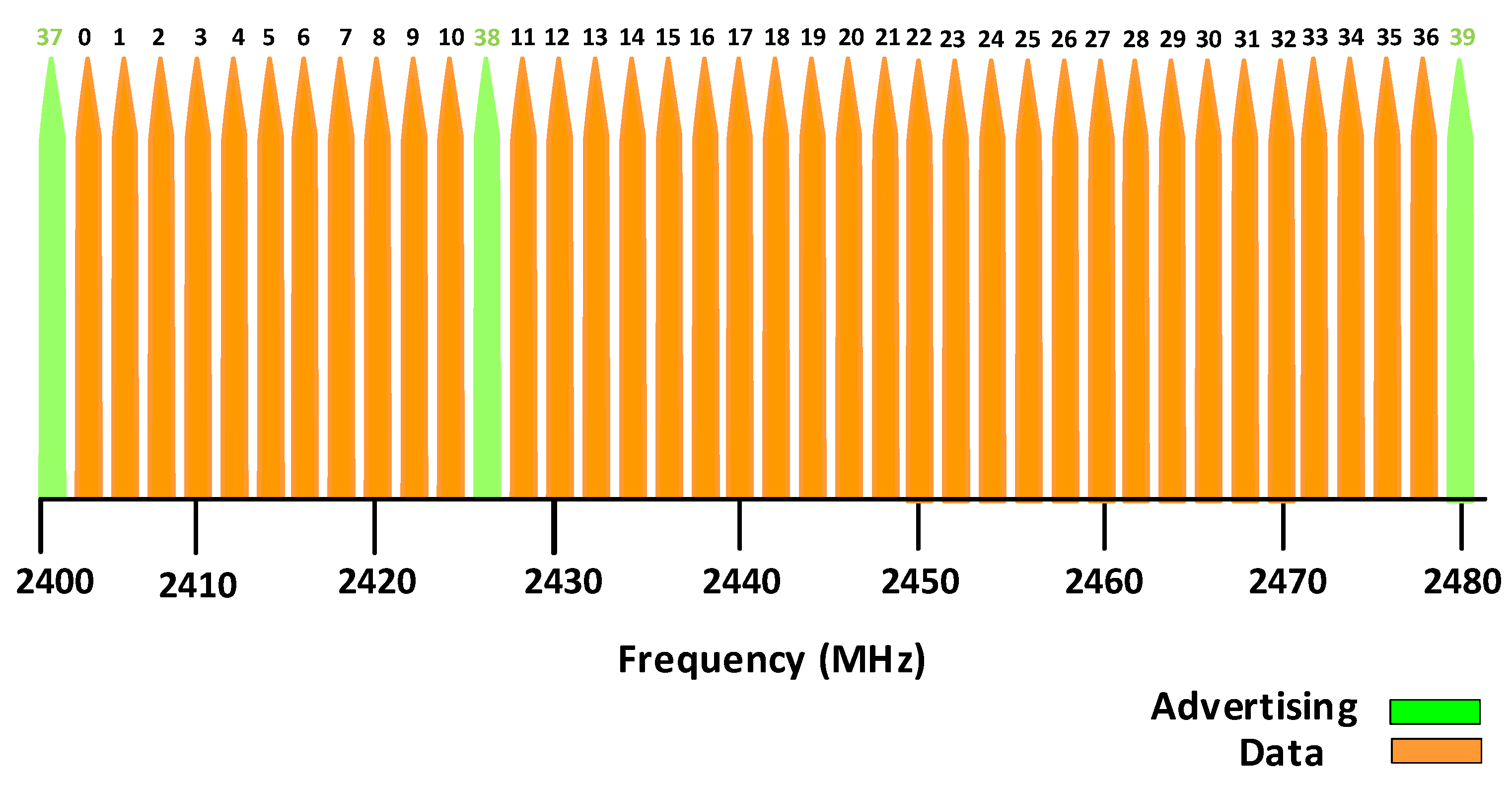
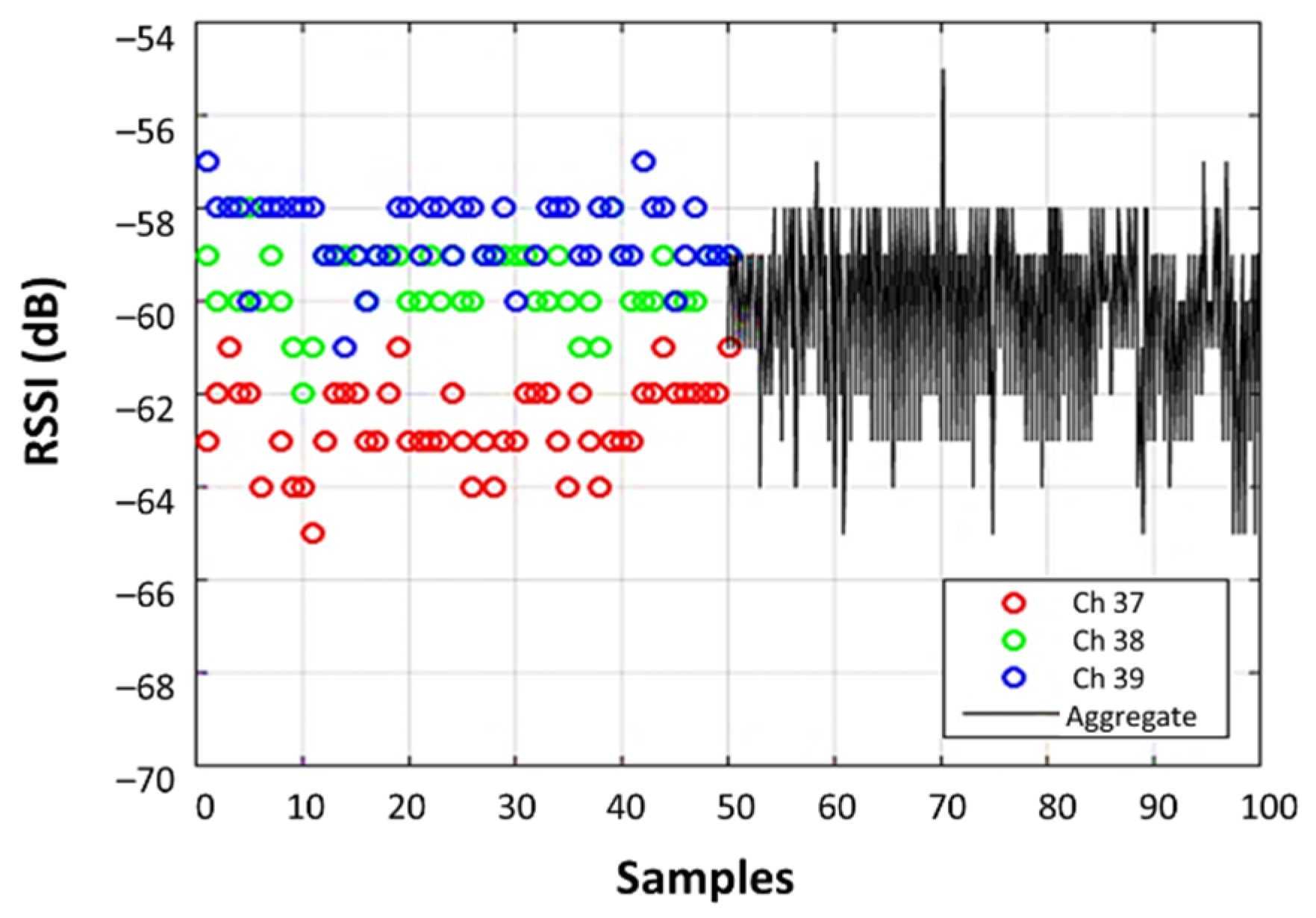


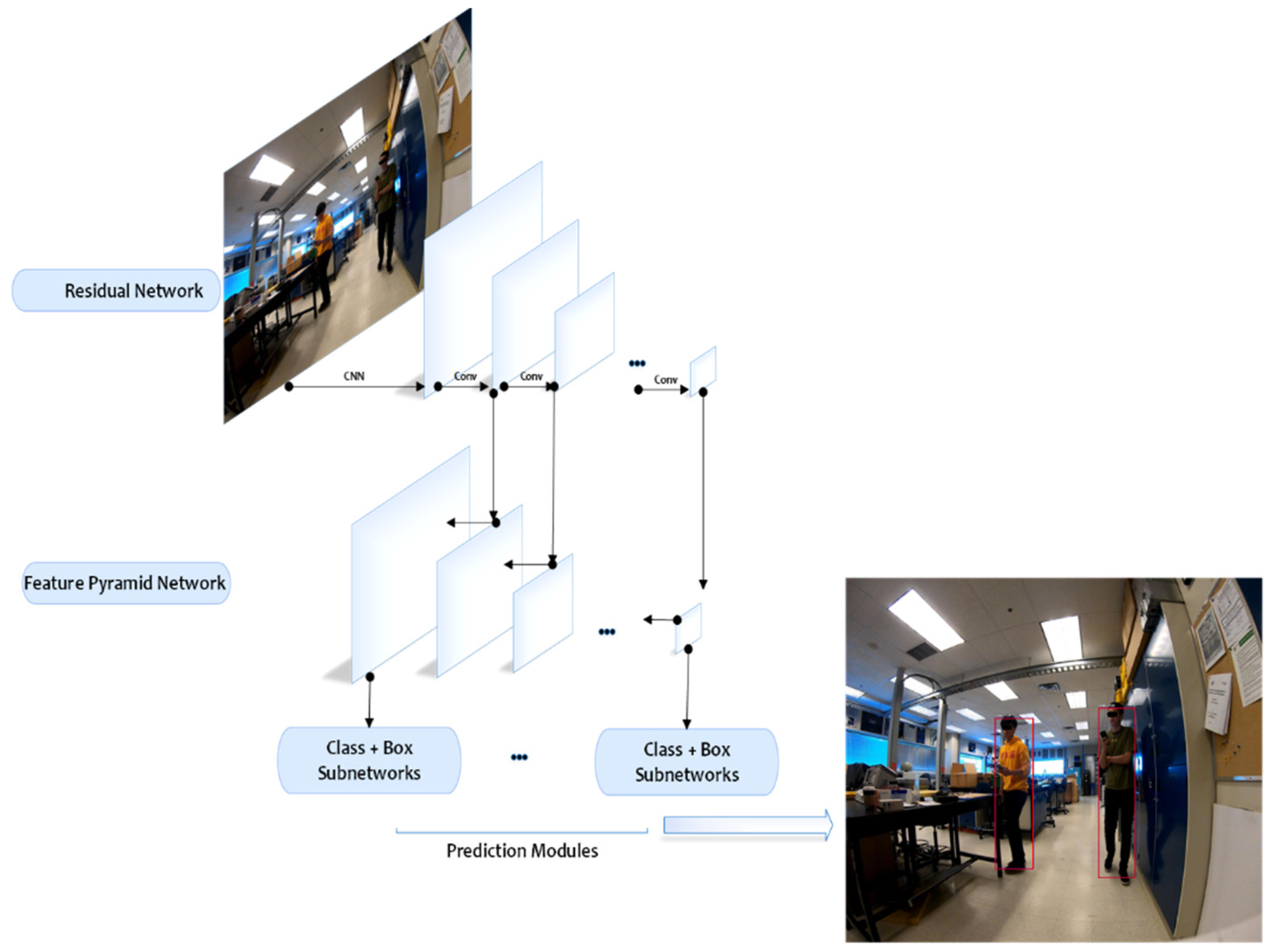


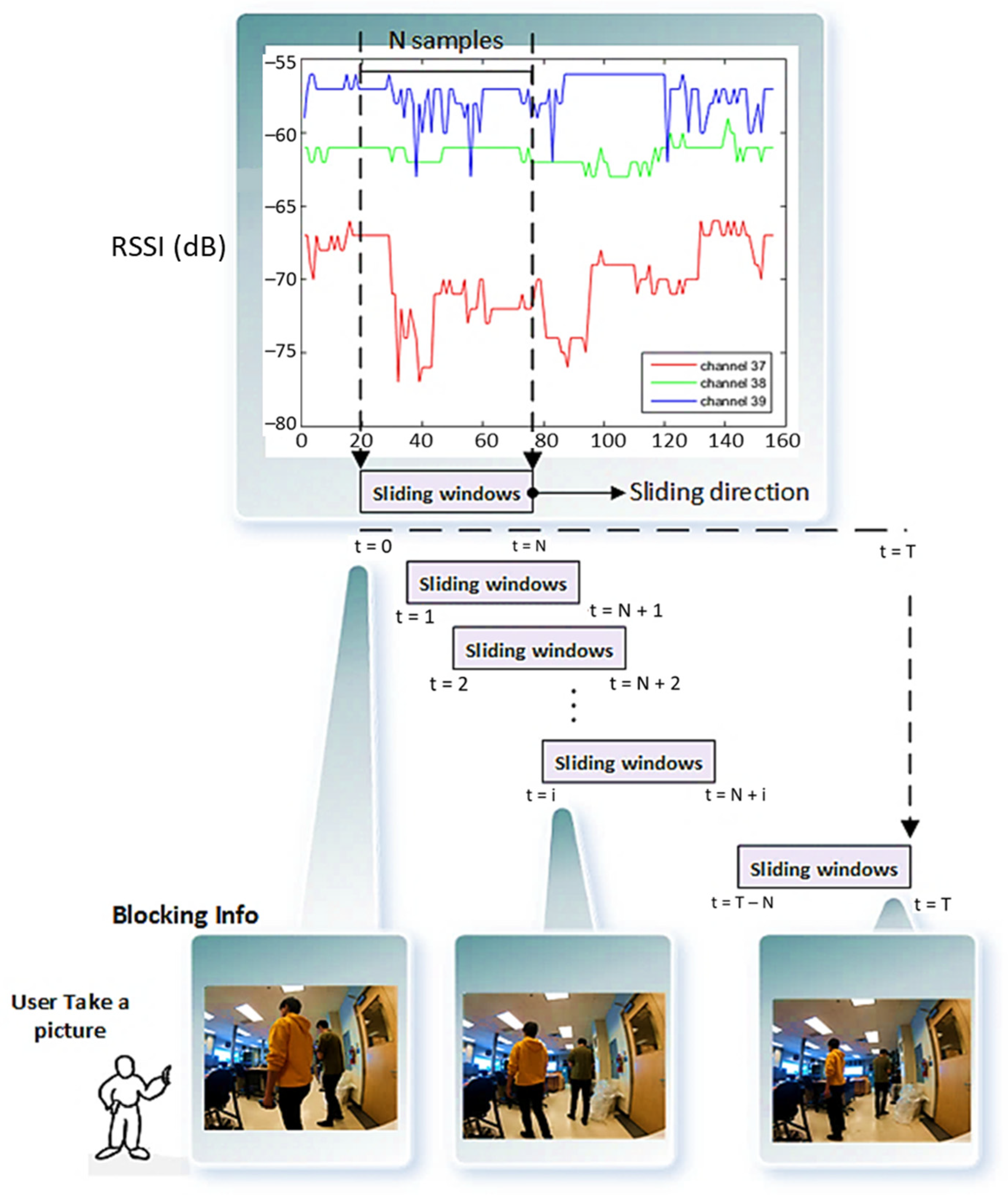
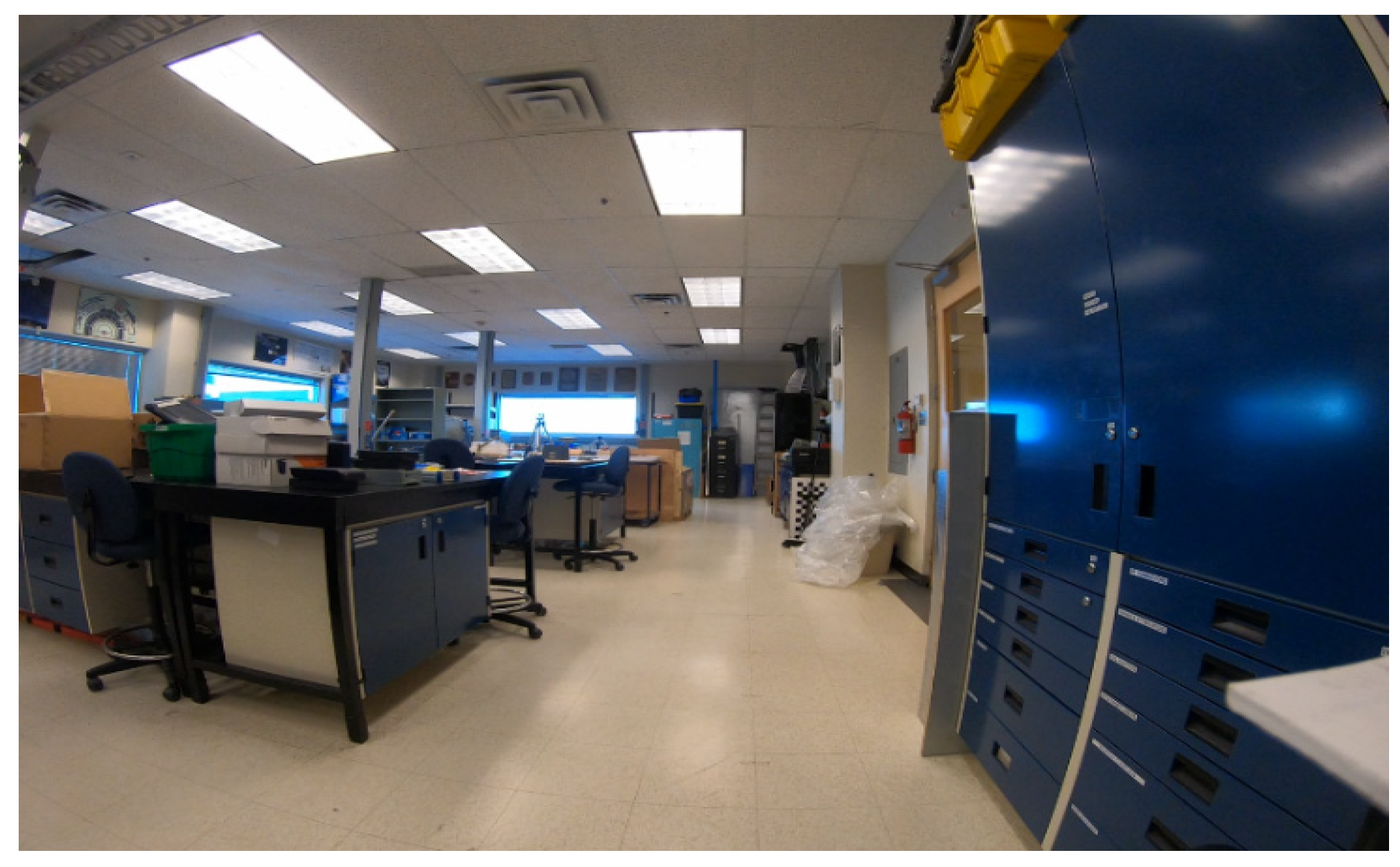
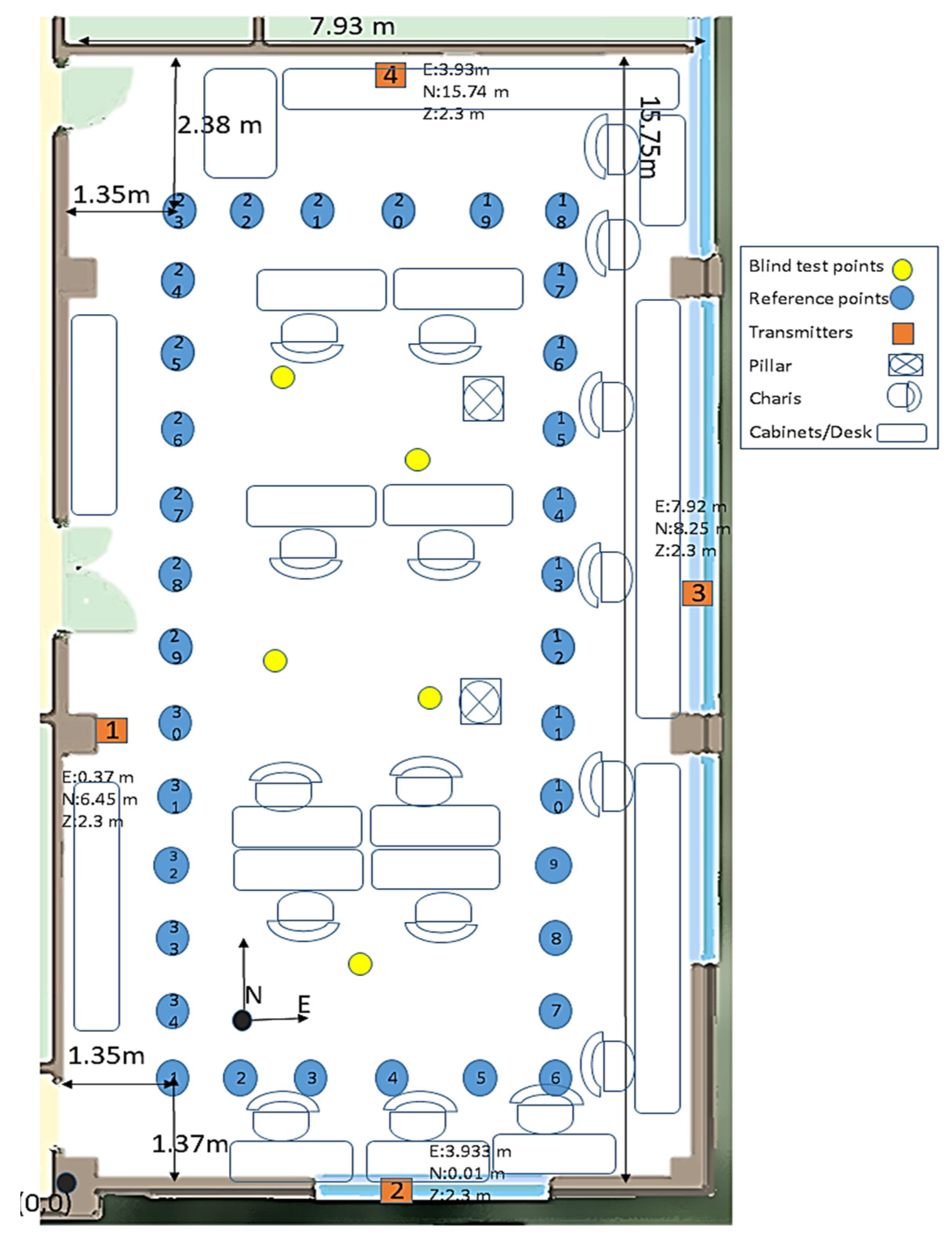
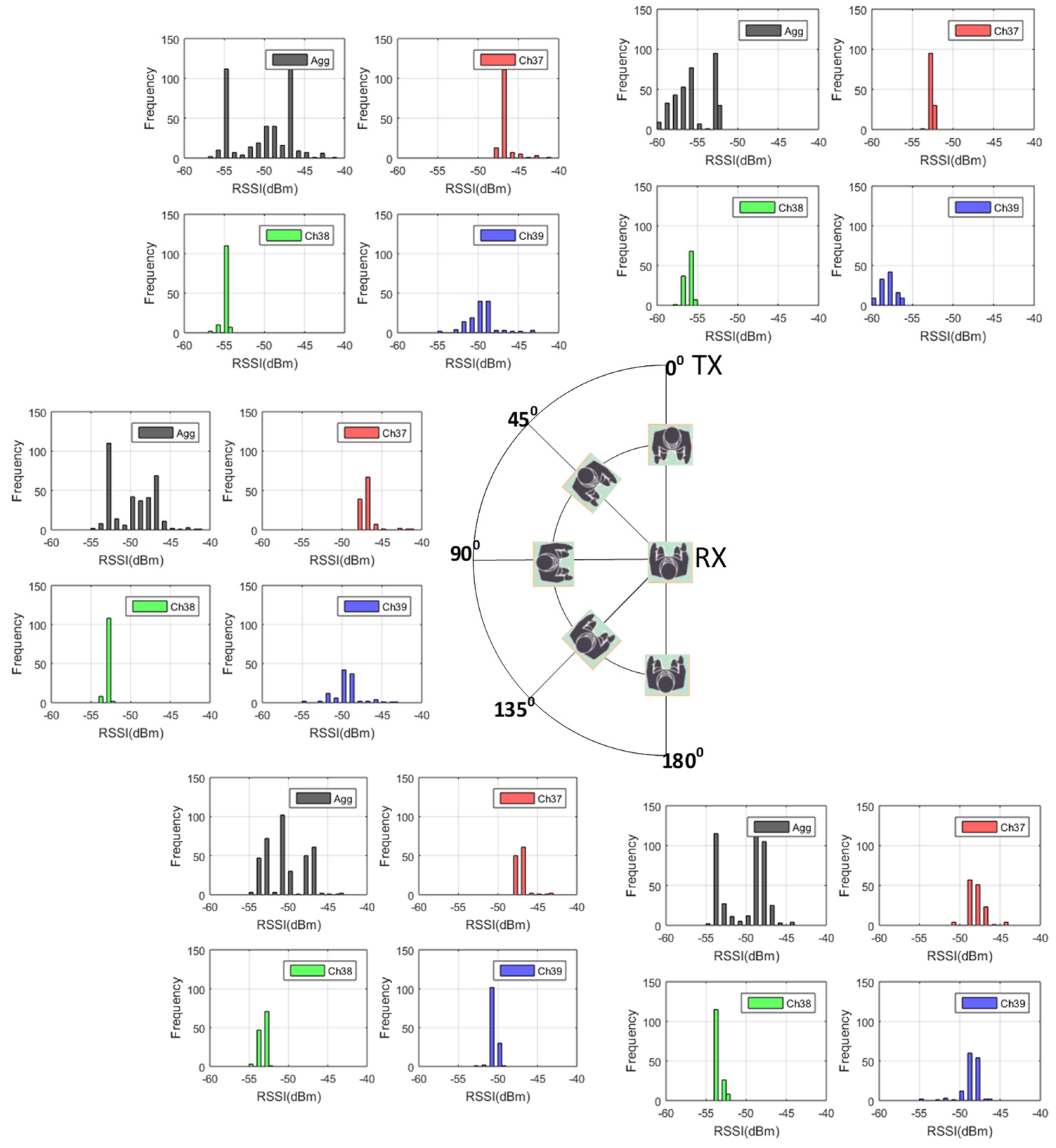


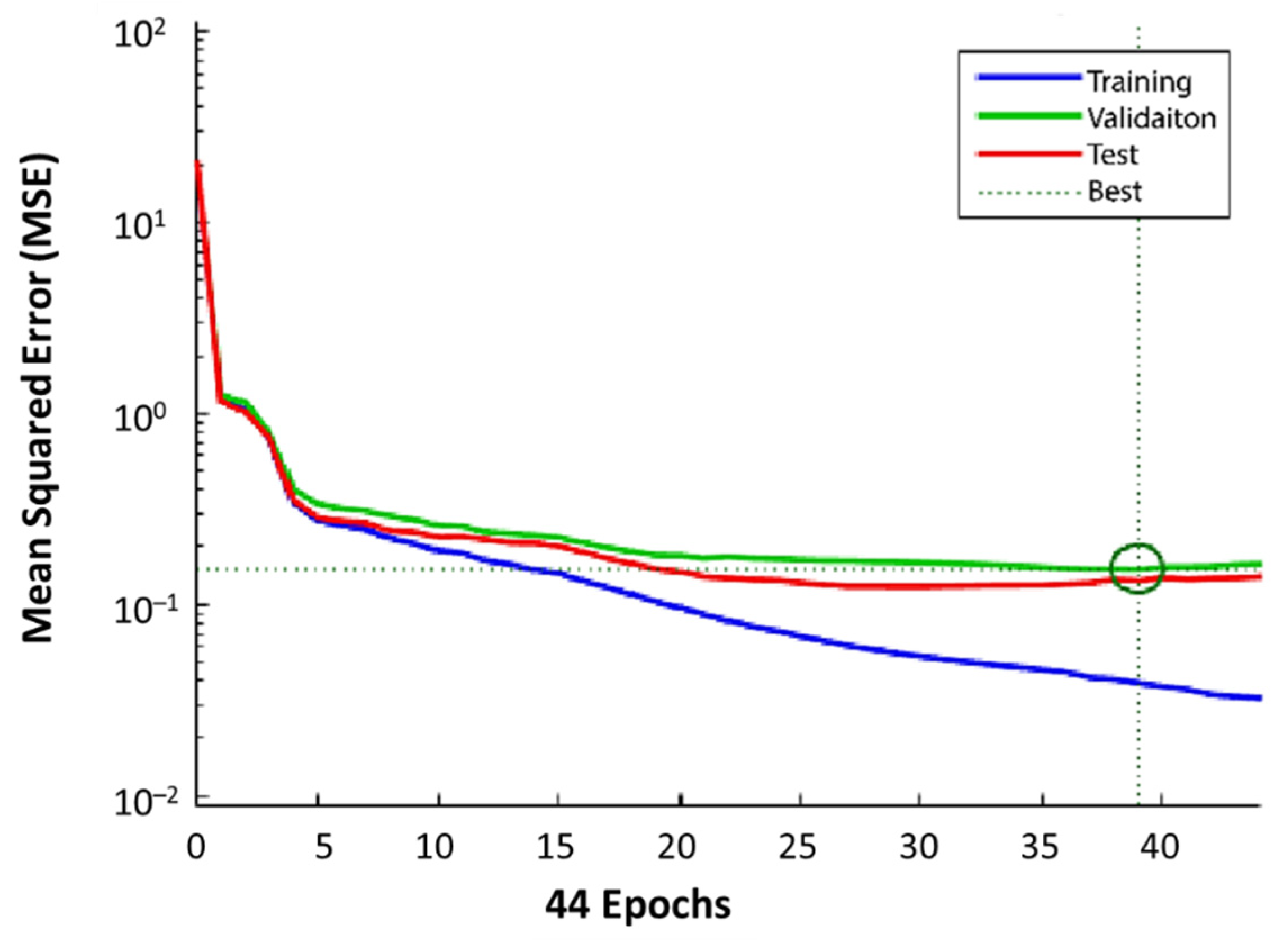
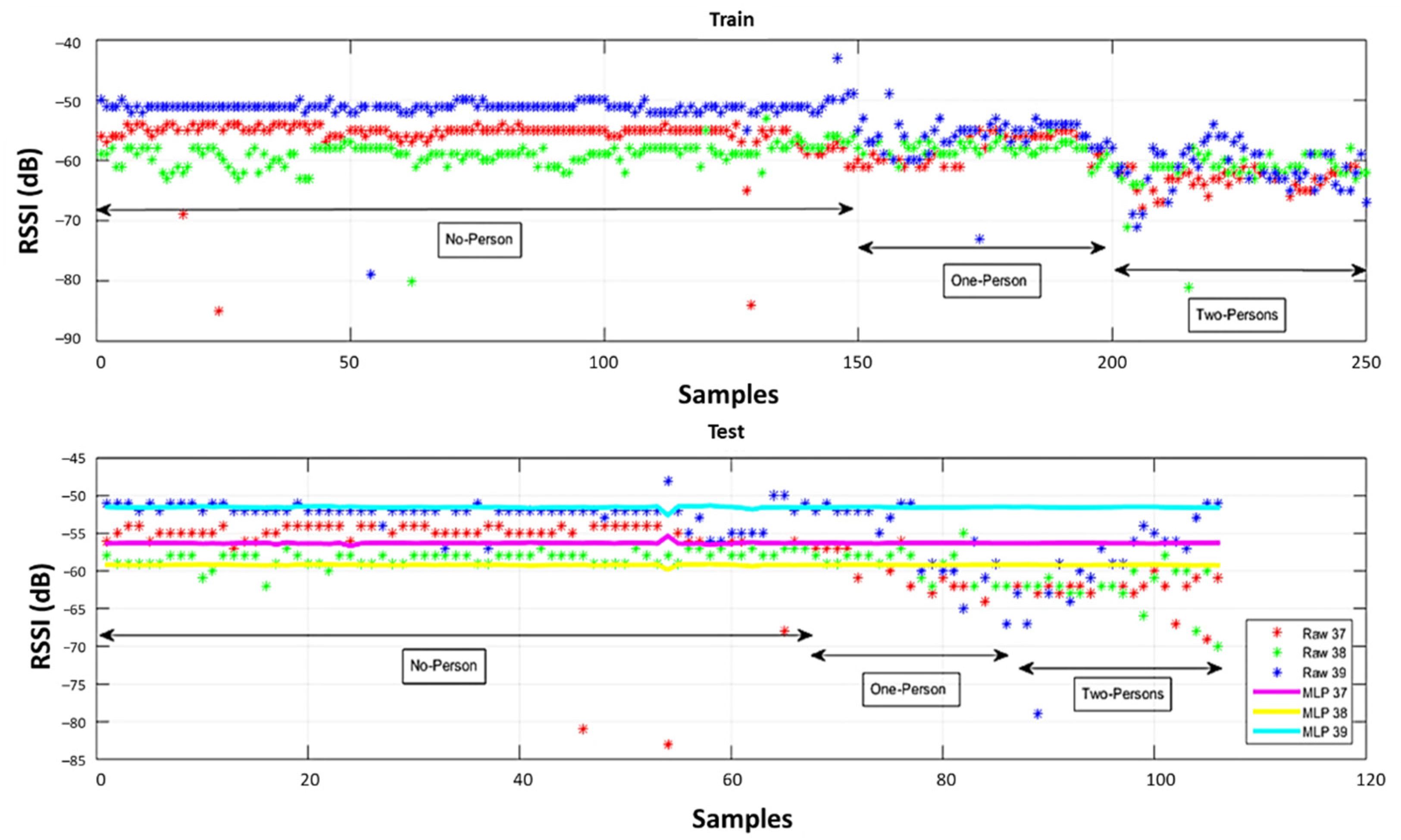

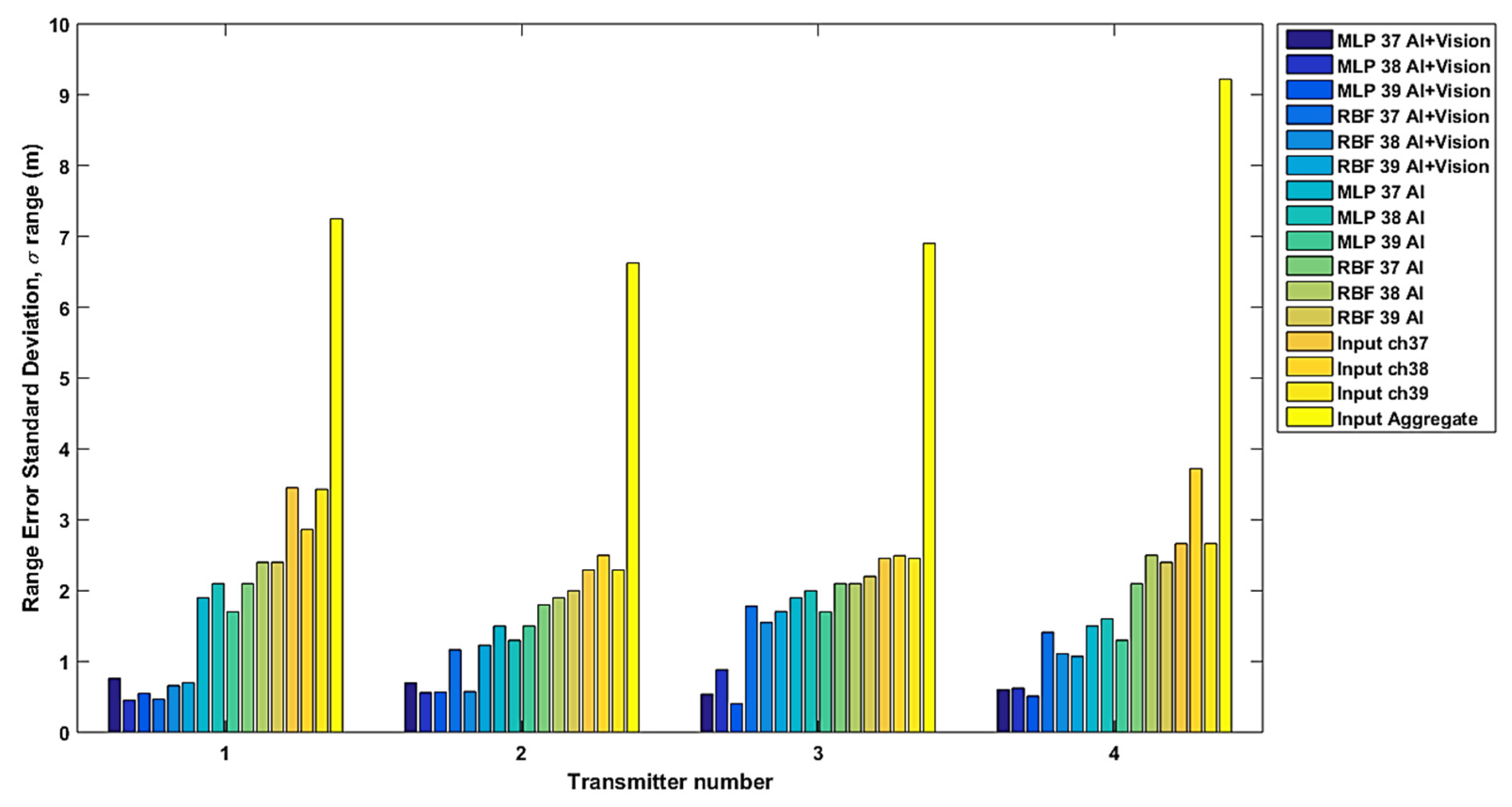

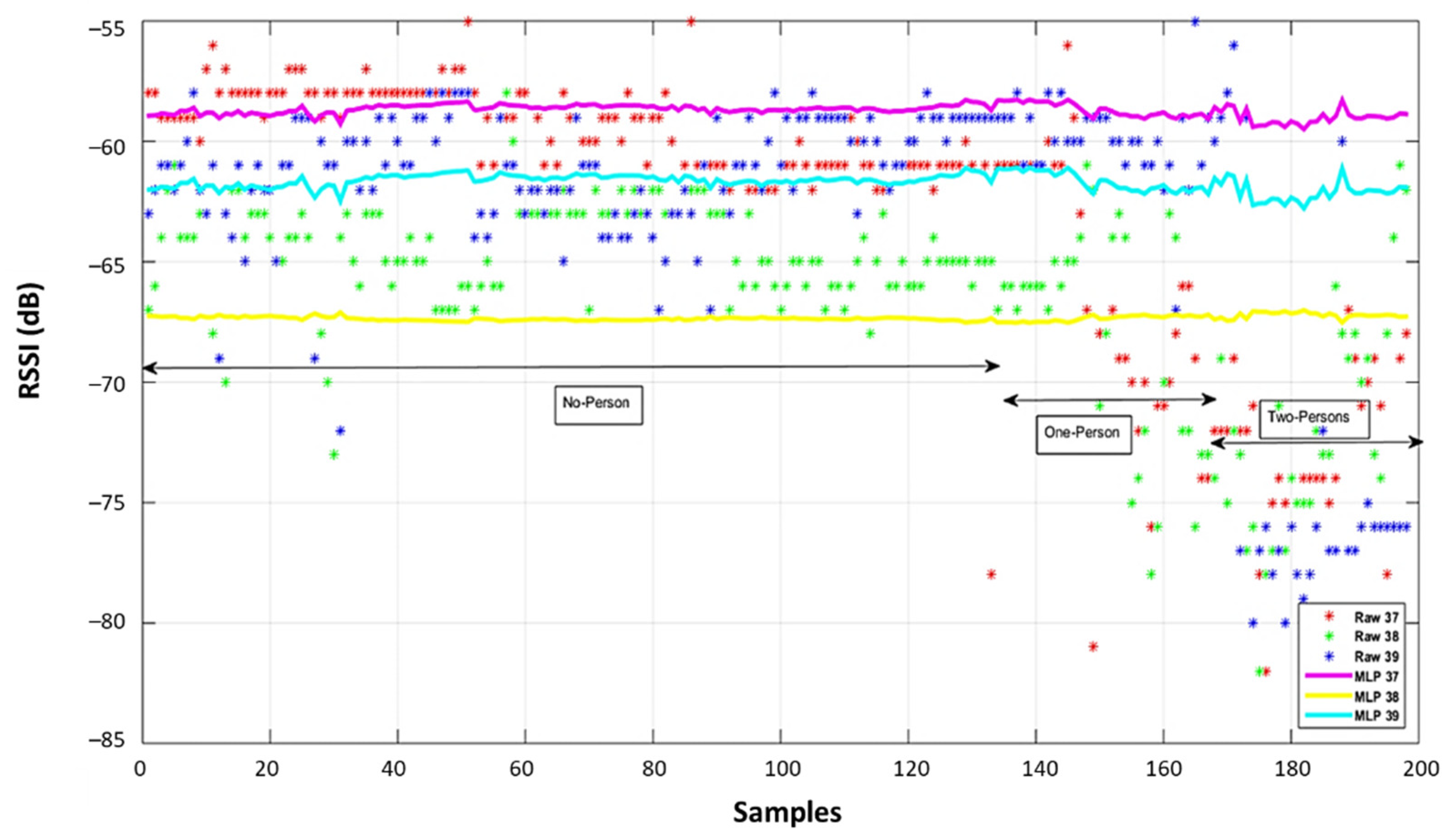
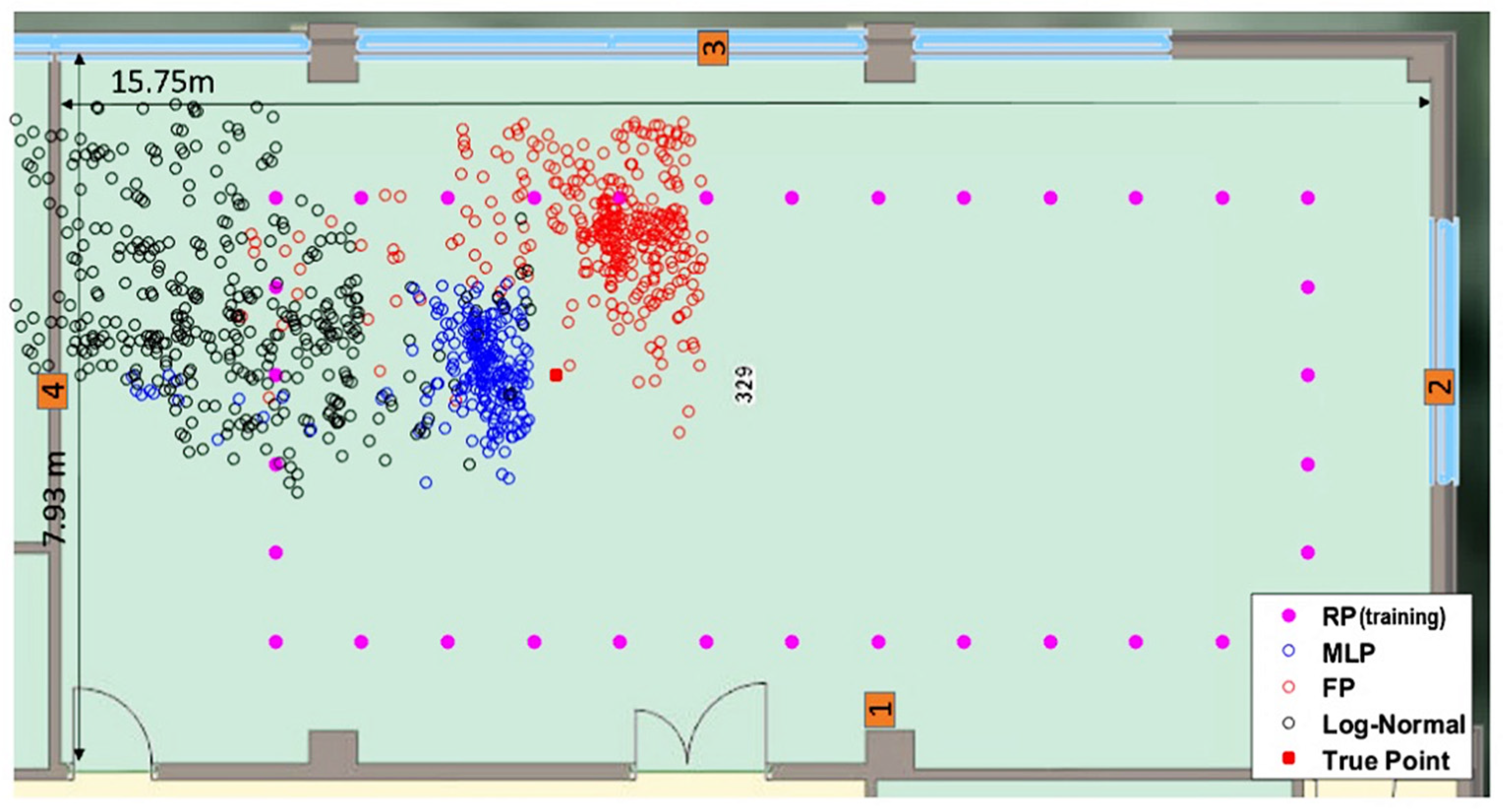

| Angle from LOS (Degrees) | Channel | Mean RSSI (dBm) | Standard Deviation (dBm) |
|---|---|---|---|
| 0 | Aggregate | −55.9 | 2.7 |
| Channel 37 | −52.7 | 0.4 | |
| Channel 38 | −56.2 | 0.6 | |
| Channel 39 | −58.7 | 1.7 | |
| 45 | Aggregate | −55 | 3.6 |
| Channel 37 | −46.8 | 1 | |
| Channel 38 | −55 | 0.4 | |
| Channel 39 | −49.8 | 1.9 | |
| 90 | Aggregate | −49.9 | 2.7 |
| Channel 37 | −47.1 | 1.1 | |
| Channel 38 | −53 | 0.3 | |
| Channel 39 | −49.7 | 1.8 | |
| 135 | Aggregate | −50.5 | 2.5 |
| Channel 37 | −47.2 | 0.86 | |
| Channel 38 | −53.4 | 0.5 | |
| Channel 39 | −50.8 | 0.5 | |
| 180 | Aggregate | −50.3 | 2.7 |
| Channel 37 | −48.2 | 1.1 | |
| Channel 38 | −53.7 | 0.5 | |
| Channel 39 | −48.8 | 1.2 |
| Angle from LOS (Degrees) | Channel | Mean (dBm) | Mean (dBm) | STD (dBm) | STD (dBm) |
|---|---|---|---|---|---|
| With People | With No People | With People | With No People | ||
| 90 | Aggregate | −62.7 | −56.2 | 5.3 | 5.6 |
| Channel 37 | −68.2 | −62.5 | 3.5 | 3.2 | |
| Channel 38 | −61.6 | −53.1 | 3.9 | 1.8 | |
| Channel 39 | −58.1 | −52.9 | 1.9 | 4.5 | |
| 180 | Aggregate | −69.1 | −61.9 | 6.7 | 6 |
| Channel 37 | −76.6 | −67.8 | 4.6 | 4.7 | |
| Channel 38 | −66 | −59.9 | 3.5 | 3.4 | |
| Channel 39 | −64.5 | −58.1 | 3.5 | 4.2 |
| Status | Samples | Percent |
|---|---|---|
| Correct detection (obstruction) | 188 | 92% |
| Missed detection | 16 | 8% |
| False alarm | 34 | 10% |
| No detection (no obstruction) | 306 | 90% |
Publisher’s Note: MDPI stays neutral with regard to jurisdictional claims in published maps and institutional affiliations. |
© 2022 by the authors. Licensee MDPI, Basel, Switzerland. This article is an open access article distributed under the terms and conditions of the Creative Commons Attribution (CC BY) license (https://creativecommons.org/licenses/by/4.0/).
Share and Cite
Naghdi, S.; O’Keefe, K. Combining Multichannel RSSI and Vision with Artificial Neural Networks to Improve BLE Trilateration. Sensors 2022, 22, 4320. https://doi.org/10.3390/s22124320
Naghdi S, O’Keefe K. Combining Multichannel RSSI and Vision with Artificial Neural Networks to Improve BLE Trilateration. Sensors. 2022; 22(12):4320. https://doi.org/10.3390/s22124320
Chicago/Turabian StyleNaghdi, Sharareh, and Kyle O’Keefe. 2022. "Combining Multichannel RSSI and Vision with Artificial Neural Networks to Improve BLE Trilateration" Sensors 22, no. 12: 4320. https://doi.org/10.3390/s22124320
APA StyleNaghdi, S., & O’Keefe, K. (2022). Combining Multichannel RSSI and Vision with Artificial Neural Networks to Improve BLE Trilateration. Sensors, 22(12), 4320. https://doi.org/10.3390/s22124320







